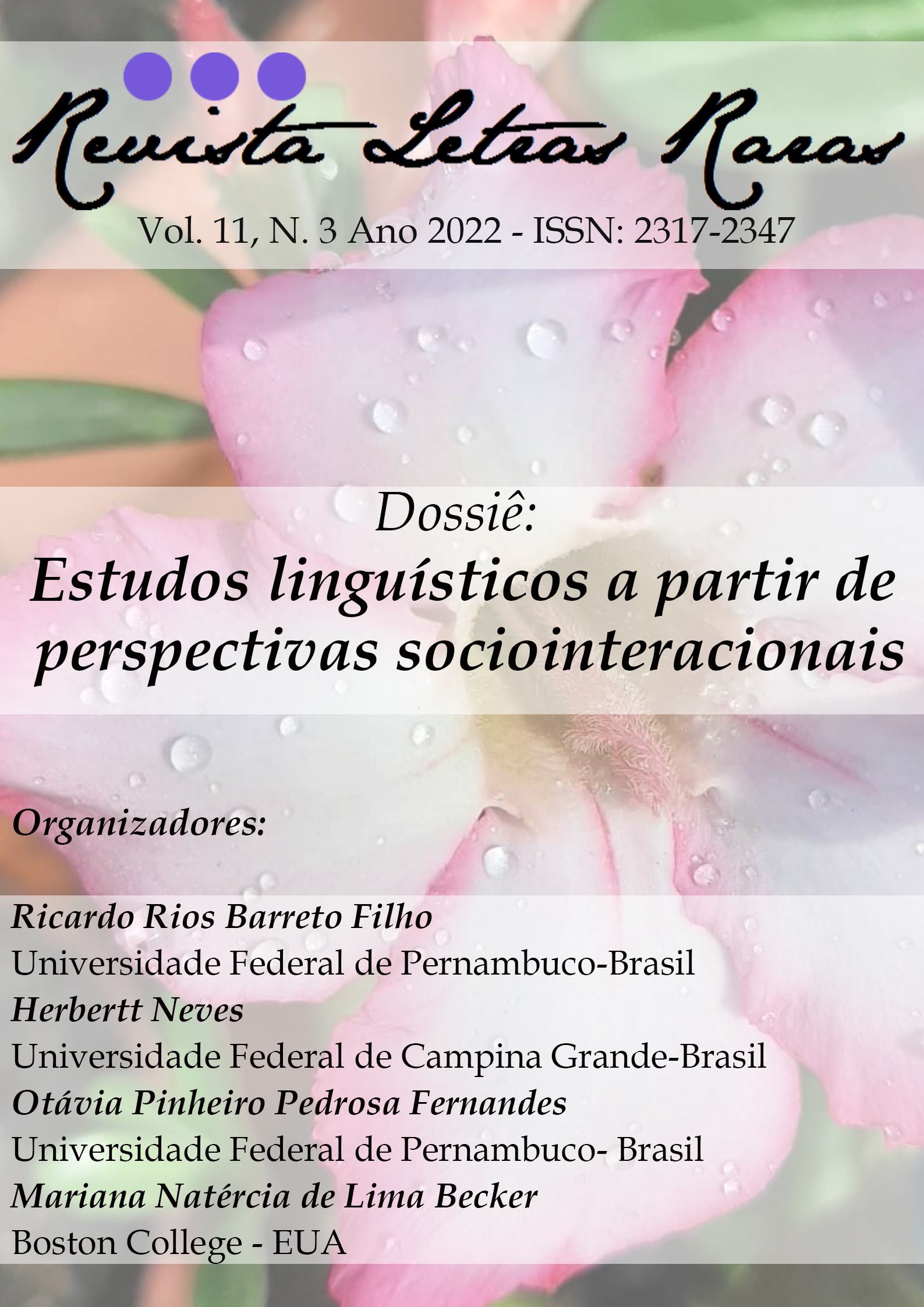The contingency of coherence in the light of context: analysis of Globo Rural tweets
DOI:
https://doi.org/10.5281/zenodo.8169940Palabras clave:
Coherence, Context, Emergence, IncorporationResumen
The present work is anchored in Textual Linguistics (TL), seeking to reflect on how the notion of context and its categories of emergence and incorporation (HANKS, 2008) contribute to the processes of building coherence in digital interactions. We conceive text as an event (MARCUSCHI, 2008; CAVALCANTE; CUSTÓDIO FILHO, 2010),encompassing in this notion the phenomenon of hypertext as a textual manifestation characterized by specificities that make even more central the notion of context and the construction of coherence in digital interactions (PAVEAU, 2020;ELIAS; CAVALCANTE, 2017). The understanding of context as movements of emergence and incorporation, where asthe construction of coherence as a highly local and contingent phenomenon, makes it possible to deal with the construction of coherence in a more systematic way. Starting from these categories and the challenge of the digitalnative text for linguistic investigation, we analyzed a tweet from the official page of the Globo Rural Magazine, observing how the incorporation to different contexts can be strategic for engagement in digital interactions. This aspect in subsequent interactions that emphasized the ambivalent character of the tweet between political and agribusiness fields. In addition, we noticed how comments to the tweet indicated a construction of meaning varying between strict meanings, meanings established in interpretive relevance or topical relevance. Therefore, it isemphasized that coherence is built on several levels, that context is built in the interaction and, mainly, that coherenceand context are highly dynamic in relation to interactions established by the participants in discursive practices.
Descargas
Citas
BEAUGRANDE, R.; DRESSLER, W. Introduction to text linguistics. Londres: Longman, 1981.
BOURDIEU, P. A gênese dos conceitos de habitus e campo. In: ______. O poder simbólico. Rio de Janeiro: Bertrand Brasil, 1989, pp. 59-73.
BOURDIEU, P. The field of cultural production: essays on art and literature. New York: Columbia University Press, 1993.
BUHLER, K. Theory of language: the representational function of language. Amsterdan: John enjamins, 1990.
CAVALCANTE, M.; CUSTÓDIO FILHO, V. Revisitando o estatuto do texto. Revista do GELNE, v. 12, n. 2, pp. 56-71, 2010.
CAVALCANTE, M. et al. O texto e suas propriedades: definindo perspectivas para análise. Revista (Con)Textos Linguísticos, v. 13, n. 25, pp. 25-39, 2019.
CAVALCANTE, M.; SILVA, T.; SILVA, Y. Dimensões analíticas da Linguística textual. In: LIMA, A.; SOARES, M.; CAVALCANTE, S. Linguística Geral: conceitos que todos precisam conhecer. São Paulo: Pimenta Cultural, 2020. pp. 17-41.
DIONÍSIO, A. P. Gêneros multimodais e multiletramento. In: KARWOSKI, A. M.; GAYDECZKA, B.; BRITO, K. (org.). Gêneros textuais: reflexões e ensino. Rio de Janeiro: Lucerna, 2006. pp. 131-144.
ELIAS, V.; CAVALCANTE, M. Linguística textual e estudos do hipertexto: focalizando o contexto e a coerência. In: CAPISTRANO JÚNIOR, R.; LINS, M. P.; ELIAS, V. Linguística textual: diálogos interdisciplinares. São Paulo: Labrador, 2017. pp. 317-338.
GOFFMAN, E. The neglected situation. In: GIGLIOLI, P. P. (org.). Language and social context: selected readings. New York: Penguin, 1972. pp. 61-66.
GUMPERZ, J. Convenções de contextualização. In: RIBEIRO, B. T.; GARCEZ, P. M. (org.). Sociolinguística interacional. Porto Alegre: Editora AGE, 1998. pp. 98-119.
HANKS, W. O que é contexto? In: _______. Língua como prática social: das relações entre língua, cultura e sociedade a partir de Bourdieu e Bakhtin. São Paulo: Cortez Editora, 2008. pp. 196-203.
KOCH, I. G. V. Introdução à linguística textual: trajetória e grandes temas. São Paulo: Martins Fontes, 2004.
KOCH, I. G. V.; TRAVAGLIA, L. C. A coerência textual. São Paulo: Contexto, 2014.
KOCH, I.; ELIAS, V. Ler e compreender: os sentidos do texto. São Paulo: Contexto, 2017.
MARCUSCHI, L. A. Coerência e cognição contingenciada. In: ______. Cognição, linguagem e práticas interacionais. Rio de Janeiro: Lucerna, 2007. pp. 13-30.
MARCUSCHI, L. A. Produção textual, análise de gêneros e compreensão. São Paulo: Parábola, 2008.
MARCUSCHI, L. A. Linguística de texto: o que é e como se faz? São Paulo: Parábola, 2012
Descargas
Publicado
Cómo citar
Número
Sección
Licencia
Derechos de autor 2023 Revista Letras Raras

Esta obra está bajo una licencia internacional Creative Commons Atribución-NoComercial 4.0.








